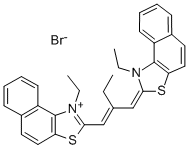STAINS-ALL
Synonym(s):1-Ethyl-2-[3-(1-ethylnaphtho[1,2-d]thiazolin-2-ylidene)-2-methylpropenyl]naphtho[1,2-d]thiazolium bromide;3,3′-Diethyl-9-methyl-4,5,4′,5′-dibenzothiacarbocyanine
- CAS NO.:7423-31-6
- Empirical Formula: C30H27BrN2S2
- Molecular Weight: 559.58
- MDL number: MFCD00078788
- EINECS: 231-047-7
- SAFETY DATA SHEET (SDS)
- Update Date: 2024-12-18 13:37:16

What is STAINS-ALL?
Chemical properties
dull dark purplish to dark grey powder
The Uses of STAINS-ALL
Stains-all is an ideal dye for the visualization and identification of proteins on polyacrylamide gels because it differentiates between highly acidic proteins which stain blue and less acidic proteins which stain pink. When employed on polyacrylamide gels, the intensity of Stains-all can be increased by the addition of silver nitrate. It is a useful nucleic acid and protein stain.
What are the applications of Application
Stains-all is a useful nucleic acid and protein stain
Definition
ChEBI: Carbocyanin DBTC is an organic bromide salt and a cyanine dye. It has a role as a fluorochrome. It contains a carbocyanin DBTC(1+).
Properties of STAINS-ALL
| Melting point: | >200℃ |
| Density | 1.3339 (estimate) |
| storage temp. | 2-8°C |
| solubility | Soluble in water, ethanol, chloroform |
| form | Dull PurplTo Powder |
| color | Dull dark purplish to dark gray |
| Water Solubility | Soluble in water. |
| Sensitive | Light Sensitive |
| λmax | 575 nm |
| BRN | 3865213 |
| Biological Applications | Detecting nucleic acid hybridization; identifying microorganisms |
| CAS DataBase Reference | 7423-31-6(CAS DataBase Reference) |
| EPA Substance Registry System | Naphtho[1,2-d]thiazolium, 1-ethyl-2-[3-(1-ethylnaphtho[1,2-d]thiazol-2(1H)-ylidene)-2-methyl-1-propenyl]-, bromide (7423-31-6) |
Safety information for STAINS-ALL
| Signal word | Warning |
| Pictogram(s) |
 Exclamation Mark Irritant GHS07 |
| GHS Hazard Statements |
H315:Skin corrosion/irritation H319:Serious eye damage/eye irritation H335:Specific target organ toxicity, single exposure;Respiratory tract irritation |
| Precautionary Statement Codes |
P261:Avoid breathing dust/fume/gas/mist/vapours/spray. P304+P340:IF INHALED: Remove victim to fresh air and Keep at rest in a position comfortable for breathing. P305+P351+P338:IF IN EYES: Rinse cautiously with water for several minutes. Remove contact lenses, if present and easy to do. Continuerinsing. P405:Store locked up. |
Computed Descriptors for STAINS-ALL
New Products
Tert-butyl bis(2-chloroethyl)carbamate 4-Methylphenylacetic acid N-Boc-D-alaninol N-BOC-D/L-ALANINOL 3-Morpholino-1-(4-nitrophenyl)-5,6-dihydropyridin- 2(1H)-one Furan-2,5-Dicarboxylic Acid Tropic acid 1,1’-CARBONYLDIIMIDAZOLE DIETHYL AMINOMALONATE HYDROCHLORIDE R-2-BENZYLOXY PROPIONIC ACID 1,1’-CARBONYLDI (1,2-4 TRIAZOLE) N-METHYL INDAZOLE-3-CARBOXYLIC ACID (2-Hydroxyphenyl)acetonitrile 4-Bromopyrazole 5-BROMO-2CYANO PYRIDINE 5,6-Dimethoxyindanone 5-broMo-2-chloro-N-cyclopentylpyriMidin-4-aMine 2-(Cyanocyclohexyl)acetic acid 4-methoxy-3,5-dinitropyridine 2-aminopropyl benzoate hydrochloride 1-(4-(aminomethyl)benzyl)urea hydrochloride diethyl 2-(2-((tertbutoxycarbonyl)amino) ethyl)malonate tert-butyl 4- (ureidomethyl)benzylcarbamate Ethyl-2-chloro((4-methoxyphenyl)hydrazono)acetateRelated products of tetrahydrofuran








You may like
-
 Thermo Scientific Chemicals Stains-All CAS 7423-31-6View Details
Thermo Scientific Chemicals Stains-All CAS 7423-31-6View Details
7423-31-6 -
 Stains-All CAS 7423-31-6View Details
Stains-All CAS 7423-31-6View Details
7423-31-6 -
 1975-50-4 98%View Details
1975-50-4 98%View Details
1975-50-4 -
 2-HYDROXY BENZYL ALCOHOL 98%View Details
2-HYDROXY BENZYL ALCOHOL 98%View Details
90-01-7 -
 2-Chloro-1,3-Bis(Dimethylamino)Trimethinium Hexafluorophosphate 221615-75-4 98%View Details
2-Chloro-1,3-Bis(Dimethylamino)Trimethinium Hexafluorophosphate 221615-75-4 98%View Details
221615-75-4 -
 14714-50-2 (2-Hydroxyphenyl)acetonitrile 98+View Details
14714-50-2 (2-Hydroxyphenyl)acetonitrile 98+View Details
14714-50-2 -
 118753-70-1 98+View Details
118753-70-1 98+View Details
118753-70-1 -
 733039-20-8 5-broMo-2-chloro-N-cyclopentylpyriMidin-4-aMine 98+View Details
733039-20-8 5-broMo-2-chloro-N-cyclopentylpyriMidin-4-aMine 98+View Details
733039-20-8
Statement: All products displayed on this website are only used for non medical purposes such as industrial applications or scientific research, and cannot be used for clinical diagnosis or treatment of humans or animals. They are not medicinal or edible.